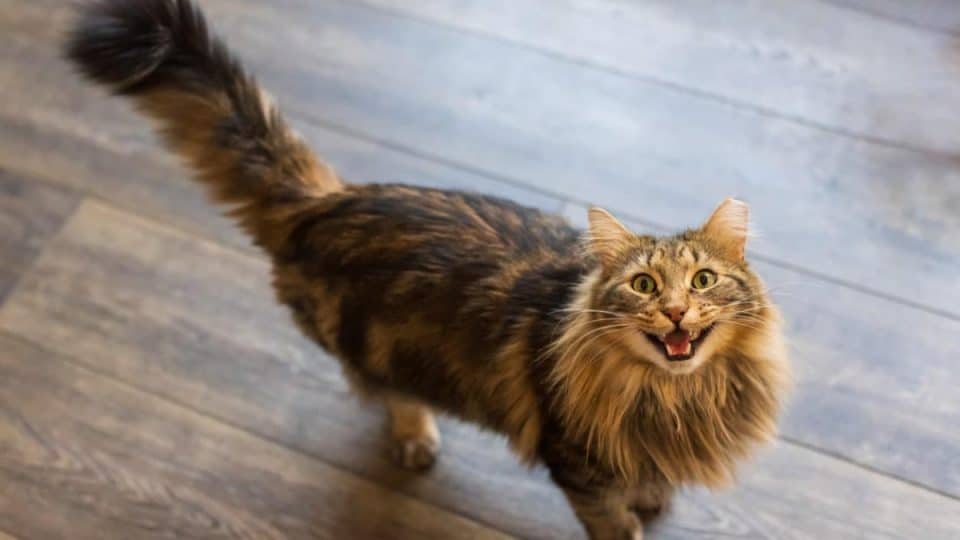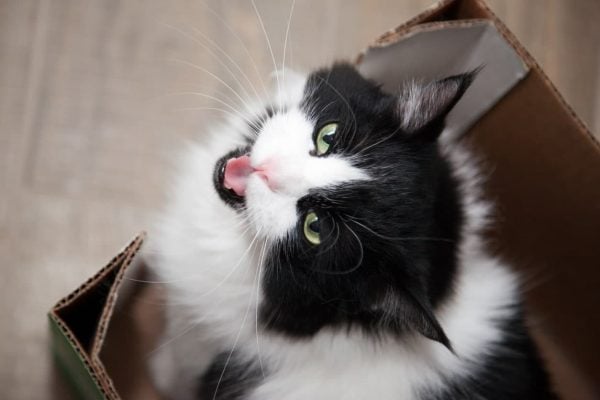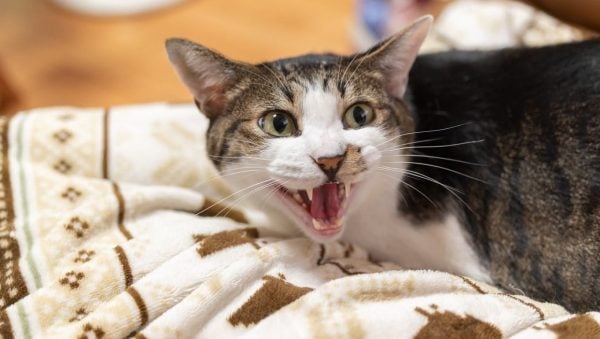- Not a substitute for professional veterinary help.
Cats can’t speak, of course, but they definitely have their own language—one full of mews, purrs, trills, and chirps. These sounds play a big part in how your cat connects with you.
Still, some new (and even seasoned!) cat parents can find it tricky to figure out what each sound means. Plus, cat sounds alone won’t always tell you exactly what your cat wants! That’s why it helps to pay close attention to their body language.
The more you tune in to your cat’s sounds and behavior, the better you’ll understand what they want to tell you. Read on to learn common cat sounds and how to tell what they mean.
Cat Sound Chart
To help decode cat sounds, we consulted two feline experts: Dr. Dean Vicksman, veterinarian and board president of EveryCat Health Foundation and Dr. Marc Smith, veterinarian at Natchez Trace Veterinary Services.
Here’s a chart of 18 common cat sounds and their possible meanings:
| Cat sound | Intention | Possible meaning |
| Meow (high pitch) | Excitement or greeting | “Where’s my food?” |
| Meow (low pitch) | Discomfort, complaint, or demand | “I’m not happy.” |
| Meow (sharp) | Discomfort or pain | “Ouch, you touched a sore spot!” |
| Meow (drawn out) | Frustration or boredom | “I don’t like what’s happening right now.” |
| Purr (soft, low pitch) | Bonding, contentment, discomfort or pain, maternal communication | “This is the best spot in the whole world.” / “I’m trying to feel better.” |
| Purr (high pitch) | Solicitation | “Hey! More food!” |
| Trill | Greeting or to get your attention | “Hi! Look at me!” |
| Yeow (drawn out) | Discomfort, anxiety, or mating call | “I’m scared.” / “I’m in heat.” |
| Yeow (high pitch, shaky) | Stress or fear | “I’m panicking!” |
| Yeow (long, guttural) | Aggression or extreme distress | “Back off—I’m ready to fight!” |
| Caterwaul | Male mating call, territorial aggression | “I’m here—come find me!” / “This is my house!” |
| Chattering (at a person) | Frustration or overstimulation | “I need a break from interaction.” |
| Chattering (at wildlife) | Excitement, predatory frustration | “Bird! Bird! Bird! I want to chase it, but I can’t!” |
| Chirp | Friendly greeting, maternal communication | “Hey, I’m here!” |
| Low growl | Warning sound, fear-based aggression | “Give me some space.” |
| Snarl | Threat or aggression | “Back off right now—or else.” |
| Spit | Threat or aggression | “Whoa! Back off!” |
| Hiss | Warning sound, fear-based aggression, or defensive aggression | “Stay away!” |
Most Common Cat Sounds
Many familiar cat sounds, like meows and trills, are made with the mouth opening and closing slowly. These tend to be friendly, social vocalizations used mainly with humans or other cats.
Meow
(mee-OW)
“Wild cats don’t meow at each other like our pet cats do with us,” Dr. Vicksman says.
Domestic cats meow because they’ve learned what sounds make people look, listen, and respond—and then fine-tuned those sounds into their own unique vocabulary.
Cats use an impressive range of meows to get attention when they want it. Some might meow in more of a rasp or croak—or even meow silently, but this is generally nothing to worry about, Dr. Vicksman says. However, if your cat’s meow or behavior suddenly changes, it’s a good idea to visit your vet.
Purr
(p-URRR)
Cats begin purring in kittenhood. Mother cats (called queens) produce a soft, low-pitched purr to soothe and bond with their kittens while nursing, and instinctively, the kittens purr back.
Adult cats purr to show contentment but also to soothe themselves when in pain or distress. Smart as they are, some cats use a special “solicitation purr” to get our attention. This purr has a high frequency, almost like a cry. Some people describe it as a mix between a purr and a meow.
It’s meant to tap into your instinct to tend to your cat—and it convinces many cat parents to hand out more food or treats!
Trill
(b-rrrp or m-rrrp)
A trill is a gentle rolling sound that falls somewhere between a purr and a meow. It’s soft and mid-pitched, typically made when the cat’s mouth is closed.
Cats usually trill as a friendly greeting or to get your attention—like when they trot over to say hello, weave around your legs, or invite you to follow them to the food bowl.
Chirp
A chirp is a brief, high-pitched sound that rises slightly at the end—just like the soft chirping of a bird. Cats may give a single chirp or a series of them, called chirrups.
A chirp often serves as a cheerful greeting between cats or toward humans, but they’re most important in communication between a mother cat and her kittens.
Queens use chirrups to announce they’re coming back to the nest or to encourage their kittens to follow along. Every mother cat’s chirp is unique, and her kittens can tell it apart from any other cat’s call.
Chatter
Chattering is when a cat quickly opens and closes their mouth, creating a soft clicking or smacking sound. Chattering usually involves little to no vocalization.
When directed at birds, squirrels, or other prey animals out the window, it’s often a mix of hunting excitement and the frustration of not being able to pounce.
If your cat chatters at you, it likely means something different—chattering combined with pacing or a flicking tail is a signal that your cat needs a break from interaction, Dr. Smith says.
Warning, Distress, and Abnormal Sounds
Open-mouth sounds like growls, yowls, hisses, and spits often signal fear, aggression, or distress. Always take these signs seriously.
Tip: Body and tail language can help show whether a cat is scared or aggressive.
“Scared cats typically retreat or cower in a corner, while aggressive cats usually stand their ground or move forward,” Dr. Smith says.
It’s important to give cats space when they make these sounds. A fearful cat may hiss or growl while backing away, but they can certainly still lash out if they feel trapped or cornered!
Hiss
Hissing is one of the clearest signals that a cat feels threatened or wants you to back off. It’s a sharp, drawn-out noise made by forcefully pushing air out through the mouth, usually on an exhale, Dr. Smith says. A hiss can happen as an involuntary reaction when startled or a deliberate warning to stay away.
If you hear this sound, it’s best to give your cat plenty of space, Dr. Smith warns. “Generally, hissing is followed by slaps, scratches, and bites.” He adds that many cat parents brush off a hiss if it happens mid-play, but it’s still a good idea to pause and give your cat a break—a hiss is never playful.
Spit
Spitting is a more intense, explosive version of a hiss, and you’ll hear it right before or after a true hiss. This quick, sharp burst of air makes a harsh sound and often happens with sudden swat or a defensive lunge. These dramatic moves typically happen in response to a threat, meant to startle or warn an opponent.
Growl
A growl is a low, rumbling sound that lasts a while and comes from a slow breath out. Your cat’s mouth might be slightly open or closed. Growls often accompany other aggressive sounds, like yowls, spits, or hisses, and may be repeated several times.
A growl is a clear sign your cat wants some space, so it’s best to give them a little room, Dr. Smith says.
Snarl
A snarl is louder, shorter, and higher pitched than a regular growl. It also comes with bared teeth. A growling cat will take a quick, deep breath in, then suddenly stops with a sharp “o” sound. This sound means business!
“These vocalizations will probably be accompanied by an upright, tense body posture, intense eye contact, and a swishing tail,” Dr. Smith explains. “The message is clear: the cat is ready to strike.”
Yowl
A yowl is a long, deep, drawn-out cry, and cats do it for a few different reasons.
For example, Dr. Smith says a yowl could mean your cat is feeling anxious, like when they yowl at night. Cats may also make this sound when in pain. A cat yowling in the litter box could have kidney stones or a urinary tract infection.
You’ll also hear a lot more yowling if your cat hasn’t been spayed or neutered. Female cats yowl when they’re in heat to attract a mate, and unneutered males yowl to announce their search for a female cat.
Caterwaul
A caterwaul is a loud, drawn-out whine with a pitch that goes up and down. It can sound a lot like a yowl. Male cats usually caterwaul to call for a mate. Females may do it to warn others or settle territorial disputes.
Aggressive cats show very different body language than those searching for a mate.
”Aggressive cats will make themselves look big and hold their ears back, showing their readiness to attack,” Dr. Smith explains. “They try to hold a much more assertive posture to serve as a warning to anyone brave enough to mess with them.”
Sounds To Ask a Vet About
Cats make a huge range of noises, and typical sounds can differ from cat to cat. But some sounds should always get your attention. If you hear any of these sounds—especially if you’ve never heard your cat make them before—check in with your vet or consider an urgent visit:
- Low-pitched meows or drawn-out yowls: These deeper, longer cries can be a sign of discomfort or pain, especially in older cats or those who don’t like how you’re handling them.
- Yowling or howling: These cries may mean your cat is in pain or feels anxious or distressed. If your cat yowls a lot, especially at night or in the litter box, it’s best to contact your vet.
- Sharp, sudden meows when touched: If your cat lets out a quick, loud meow when you touch a certain area, they may be telling you that spot hurts.
- Sneezing, wheezing, or trouble breathing: Any time your cat has difficulty breathing or starts wheezing, you should call your vet right away or take them straight to the emergency vet.
Dr. Vicksman says you generally don’t need to worry about a silent meow, a naturally raspy meow, reverse sneezing, or the occasional snort. However, if the sound is new for your cat or happens with other changes in behavior, it’s a good idea to make an appointment with your vet.
Do Cats Understand When You Meow Back?
Many cat parents find themselves instinctively meowing or chirping back at their feline friends. If you do this too, good news: Dr. Vicksman says not all of those meows get lost in translation. It’s one way of speaking your cat’s love language.
“Cats recognize tone and rhythm, even if they don’t understand the exact meaning,” he says. “Mimicking their trills or chirps can sometimes encourage interaction—they know you’re engaging with them.”
That said, it’s best to avoid mimicking intense or aggressive sounds like hisses, growls, or spits.
Imitating aggressive noises can confuse or stress your cat and potentially escalating their defensive behavior, Dr. Smith says. Instead, if your cat shows signs of distress or aggression, try redirecting their energy with toys or treats and give them space to calm down.
Ultimately, speaking your cat’s language isn’t about perfectly imitating every meow or chirp—or even fully understanding each sound. It’s about tuning in and responding with care!





